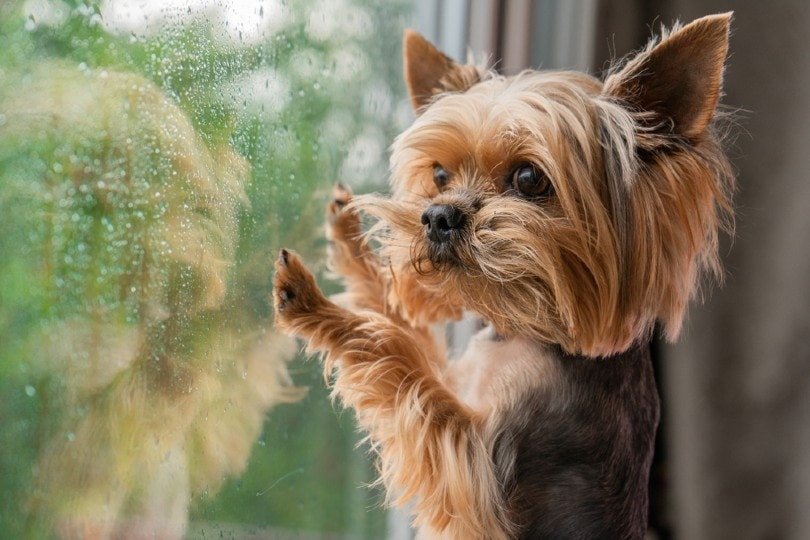How Long Do Maltipoos Live? Average Lifespan, Data & Care

Updated on

Click to Skip Ahead
A Maltipoo is a unique cross between a Maltese and a Poodle. These two breeds are both known for their friendly natures and attractive looks, and the cross between them produces a sweet-natured, teddy bear-looking dog that has won hearts worldwide.
Maltipoos live between 10 to 13 years, but does the mix affect the dog’s longevity? This article will look in detail at how long a Maltipoo lives on average and what can affect their lifespan.
What’s the Average Lifespan of a Maltipoo?
The average lifespan of a Maltipoo crossbreed is 10 to 13 years old. The breed is classed as a small breed, and the average lifespan of a smaller dog is the same—10 to 13 years. This compares to the average for all dog breeds, with some noticeable outliers being the giant breeds. Dogs weighing more than 90 pounds usually only live seven or eight years on average.

Why Do Some Maltipoos Live Longer Than Others?
Several factors contribute to a dog’s average lifespan, from genetics to illness to housing and economics. While the average Maltipoo will live from 10 to 13 years, these factors may reduce or lengthen their lives (sometimes even considerably):
1. Nutrition
Nutrition plays a big part in the longevity of a dog, and the same is true for the Maltipoo. Usually, a good diet and a healthy weight mean better overall health for dogs. Keeping these sweet dogs at an ideal weight and feeding them the recommended daily amount of food (or even slightly under, as this study demonstrates) will extend their lives.
Signs and symptoms of illness related to age and excess weight are reduced in dogs that are fed 25% less than their counterparts. This is especially true when paired with a diet rich in vitamins, minerals, ad essential fatty acids (which have been shown to protect the brain and boost the immune system in dogs of all ages). Skin diseases, obesity, and growth disorders occur when a dog is fed a nutritionally poor diet, lowering its life span.
2. Environment
The environment a Maltipoo is kept in can directly affect its lifespan, which is usually seen in poor environments causing chronic stress and anxiety.
Chronic stress in dogs, such as dogs with a fear disorder (fear of strangers, for example), has been shown to decrease lifespan, meaning high-stress environments can cause a dog to live for a shorter time than those not dealing with stress.
In addition to stress, dirty or unhygienic environments can cause disease to spread. In puppies, this can cause death from infectious and devastating diseases such as canine parvovirus.
3. Housing
A Maltipoo should live in housing that’s size appropriate and shouldn’t be kept outside. Evidence suggests that keeping a dog outside (specifically on a chain or tether) profoundly affects their health and well-being; in some cases, it increases aggression and the likelihood of a bite attack. Trauma from animal attacks or vehicular accidents also lowers the lifespan of outdoor dogs and is less likely to occur in indoor dogs.

4. Size
The larger a dog is, the shorter its lifespan is. There are many theories about why this is since, generally, the larger an animal is, the longer it lives. But for dogs, the reverse is true: larger dogs live shorter lifespans than smaller dogs, with some breeds (such as Chihuahuas) living into their 20s.
This could be due to larger dogs having faster metabolisms than smaller ones, and puppies are more susceptible to abnormal cell growth resulting in cancers.
5. Sex
The sex of a Maltipoo doesn’t affect its lifespan, and a new study shows that there is little difference in the lifespans of dogs due to gender. Female dogs in the study lived marginally longer, but the amount was insignificant. However, whether the dog was fixed played a bigger part.
6. Genes
A dog may have a longer or shorter lifespan than others if it is more prone to certain health conditions due to genetics. In the Maltipoo, genetic dispositions from both the Poodle and Maltese side of the pairing can cause inherited conditions that significantly impact lifespan. Conditions include Patent Ductus arteriosus, white shaker syndrome from the Maltese side, leg-calve-Perthes disease, and patellar luxation from the toy/ miniature Poodle side.

7. Breeding History
Breeding history affects a dog’s lifespan in a few ways. Neutering a dog will increase its lifespan by years and reduces the chance of death from several causes, such as infection and trauma. There are no risks to preventing breeding, but for queens, having a litter of puppies carries its risks that can shorten lifespan, including dystocia (problems giving birth), risk of womb infections (pyometra), and trauma during the birth.
8. Healthcare
If a dog is not cared for properly and doesn’t visit the vet, its life span can be reduced. However, even a few vet visits a year can increase your Maltipoo’s life span. These can help highlight any potential hidden problems or subtle symptoms, making them more likely to be successfully treated if caught early.
9. Socialization
A dog’s behavior can affect how long it lives, and that is especially true with socialization. The socialization period is crucial for getting your dog used to other dogs and learning how to behave. Poor socialization is linked to lower lifespans due to behavioral problems in the future and the possibility of going to a shelter.
 The 4 Life Stages of a Maltipoo
The 4 Life Stages of a Maltipoo
Knowing what to expect when your Maltipoo is growing up can help you plan and budget for every part of their care at each stage. While most dogs follow the same stages and periods, very large or small breeds (like the Maltipoo) will differ.
1. Puppy: Birth to 6 to 9 months
A Maltipoo puppy will be born blind and deaf like all puppies and will rely entirely on its mother for warmth and sustenance. Providing the mother with a warm and comfy den or bed can help her support her puppies.
Once their eyes and ears open between 2 and 4 weeks, their world expands endlessly. At 4 weeks, a Maltipoo will start to walk, bark, and communicate with their littermates (by wagging their tail!).
After this period, independence begins to blossom. A Maltipoo will begin to socialize and will experience all the sights and sounds of life while weaning off the mother and standing on its own four feet.

2. Young Adult: 9 months to 3 or 4 years
Your Maltipoo will be fully grown in around a year, and now is the time to transition them to a high-quality adult dog food. Change the diet slowly to avoid stomach upset and get them into a good routine now that’ll see them through to their twilight years.

3. Mature Adult: 7 years to 10 years
Your Maltipoo will now be fully grown and will have reached emotional and physical maturity. A fully grown Maltipoo can vary in height as they are a crossbreed, but on average, they’re around 14 inches tall (maximum) and typically weigh between 5 to 20 pounds.
Keeping them on a good exercise regime and nutritious diet will help them fight the first signs of aging in dogs and protect their teeth, joints, and brains into old age.

4. Senior: 10 years +
A Maltipoo can live up to 15 years, so ensuring they enjoy their twilight years is vital for their happiness and welfare. A good senior diet rich in omega-3 and 6 fatty acids are key to supporting healthy immune, brain, and joint functions, and combined with gentle exercise, they can help to fight inflammation from arthritis.

 How To Tell Your Maltipoo’s Age
How To Tell Your Maltipoo’s Age
Trying to figure out how old your Maltipoo is can be challenging, but there are certain ways you can estimate the age:
- By looking at their teeth, such as looking for broken/ missing teeth, gum disease, and dental tartar
- By looking for cloudiness in the eyes (cataracts)
- By looking for greying of the fur (in darker Maltipoos)
- Bodily changes such as different fat distribution and muscle wastage
Final Thoughts
Maltipoos are generally healthy pups, but their environment, upbringing, and frequency of vet appointments can affect their lifespans. Keeping them safe, making regular trips to the vet to keep them healthy, and maintaining a good diet and weight are all ways an owner can help to increase their Maltipoo’s lifespan while keeping their quality of life amazing. Doing so means you can enjoy every moment with the Maltipoo you possibly can.
See Also:
Featured Image Credit: noelle, Unsplash


 The 4 Life Stages of a Maltipoo
The 4 Life Stages of a Maltipoo









